![]()
![]()
![]()
Use LEFT and RIGHT arrow keys to navigate between flashcards;
Use UP and DOWN arrow keys to flip the card;
H to show hint;
A reads text to speech;
82 Cards in this Set
- Front
- Back
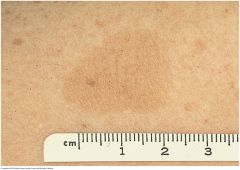
|
Cafe-Au-Lait-Spot |
|

|
Vitiligo Depigmented macules appear on the face, hands, feet, extensor surfaces, and other regions and may coalesce into extensive areas that lack melanin |
|
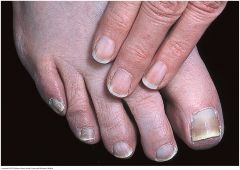
|
Cyanosis Somewhat bluish color that is visible in these toenails and toes; may be hard to distinguish |
|
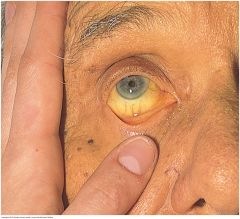
|
Jaundice Skin diffusely yellow; seen most easily in the sclera |
|

|
Carotenemia Yellow palm; does not effect the sclera; cause is a diet high in carrots and other yellow vegetables or fruits |
|
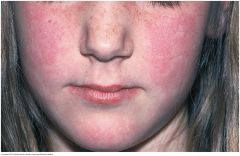
|
Erythema Red hue, increased blood flow ("Fifth disease") |
|
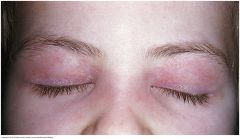
|
Heliotrope Violaceous patches over the eyelids in the collagen vascular disease dermatomyositis |
|
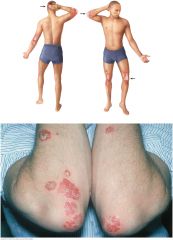
|
Psoriasis Silvery scaly papules or plagues, mainly on the extensor surfaces |
|
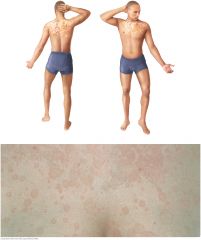
|
Tinea Versicolor Tan, flat, scaly plagues |
|
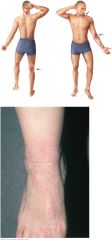
|
Atopic Eczema Mainly appeard on flexor surfaces (adult form) |
|
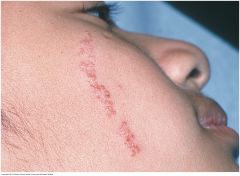
|
Linear Lesion Pattern Linear epidermal nevus |
|
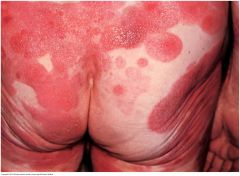
|
Geographic Lesion Pattern Mycosis fungoides |
|
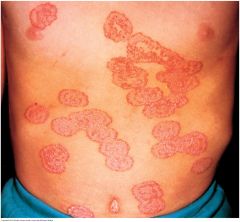
|
Serpiginous Lesion Pattern Tinea corporis |
|
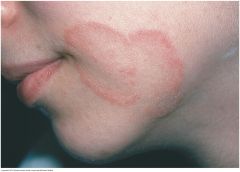
|
Annular, arciform Lesion Pattern Annular plaque of tinea faciale |
|
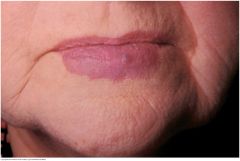
|
Hemangioma Primary Skin Lesion (Flat, Nonpalpable) Macule |
|
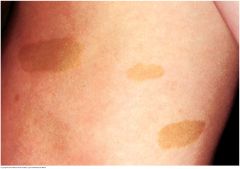
|
Hemangioma Primary Skin Lesion (Flat, Nonpalpable) Patch (Cafe Au Lait Spot) |
|
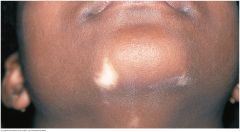
|
Vitiligo Primary Skin Lesion (Flat, Nonpalpable) |
|
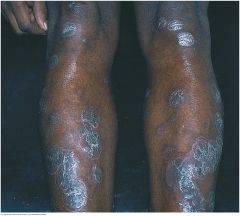
|
Psoriasis (Palpable) Plaque, coalescence of papules |
|
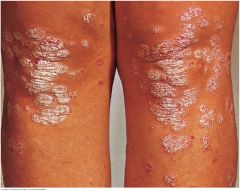
|
Psoriasis (Palpable) Plaque, coalescence of papules |
|
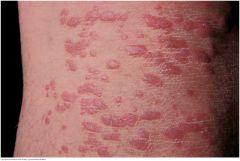
|
Psoriasis (Palpable) Plaque, coalescence of papules |
|
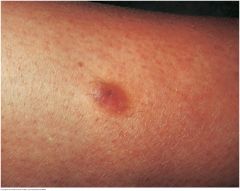
|
Dermatofibroma (Palpable) Nodule; knot-like lesion |
|
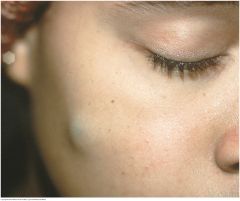
|
Epidermal Inclusion Cyst (Palpable) Nodule filled with expressible material, either liquid or semisolid |
|

|
Uriticaria (Palpable) Wheal; Somewhat irregular, relatively transient, superficial area pf localized skin edema |
|
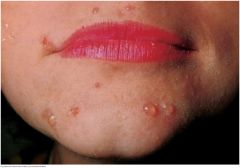
|
Herpes Simplex (Palpable Fluid-Filled) |
|
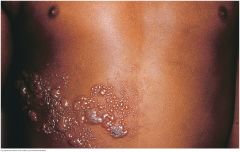
|
Herpes Zoster (Palpable Fluid-Filled) |
|
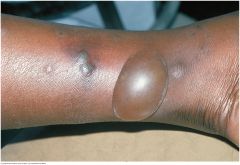
|
Insect Bite (Palpable Fluid-Filled) Bulla |
|
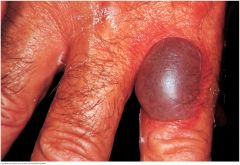
|
Insect Bite (Palpable Fluid-Filled) Bulla |
|
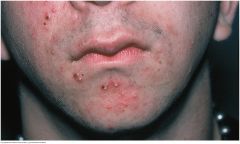
|
Acne (Palpable Fluid-Filled) Pustule; filled with pus
|
|
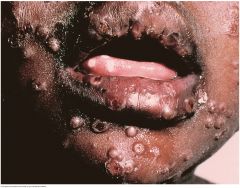
|
Small Pox (Palpable Fluid-Filled) Pustule; filled with pus |
|
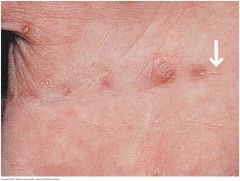
|
Scabies (Palpable Fluid-Filled) Burrow; a minute, slightly raised tunnel in the epidermis, commonly found on finger webs and on the side of fingers. Looks like a short, linear or curved line and may end in a tiny vesicle; with a magnifying lens, you can be the burrow of the mite that causes scabies |
|
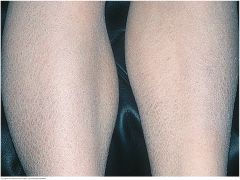
|
Ichthyosis Vulgaris (Secondary Skin Lesion) Scale; thin flake of dead exfoliated epidermis |
|

|
Dry Skin (Secondary Skin Lesion) Scale; thin flake of dead exfoliated epidermis |
|

|
Impetigo (Secondary Skin Lesion) Crust; dried residue of skin exudates such as serum, pus or blood |
|

|
Neurodermatitis (Secondary Skin Lesion) Visible and palpable thickening of the epidermis and roughening of the skin with increased visibility of the normal skin furrows (often from chronic rubbing) |
|
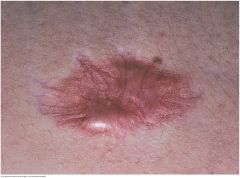
|
Hyperthrophic Scar From Steroid Injections (Secondary Skin Lesion) Increased connective tissue that arises from injury or disease |
|
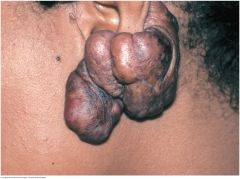
|
Keloid - ear lobe (Secondary Skin Lesion) Hypertrophic scarring that extends beyond the borders of the intiating injury |
|
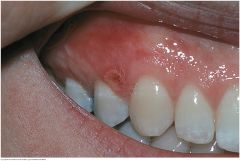
|
Erosion (Secondary Skin Lesions - Depressed) Nonscarring loss of the superficial epidermis; surface is moist but does not bleed Ex: Aphthous stomatitis - moist area after the rupture of a vesicle; chickenpox |
|
|
Excoriation |
Linear or punctate erosions caused by scratching |
|
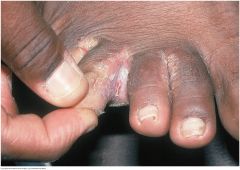
|
Fissure (Secondary Skin Lesions - Depressed) A liner crack in the skin, often resulting from excessive dryness Ex: Athlete's foot |
|
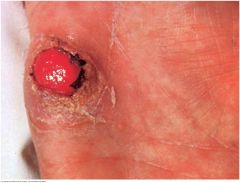
|
Ulcer (Secondary Skin Lesions - Depressed) A deeper loss of epidermis and dermis; may bleed and scar Ex: Stasis ulcer of venous insufficiency, Syphilitic chancre |
|
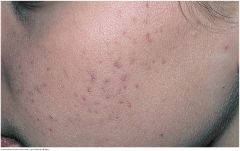
|
Acne Vulagris Primary Lesion Mild Acne Open and closed comedones (blackheads), occasional papules |
|
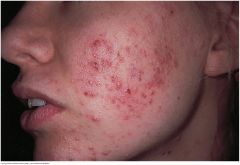
|
Acne Vulagris Primary Lesion Moderate Acne Comedones, papules, pustules |
|
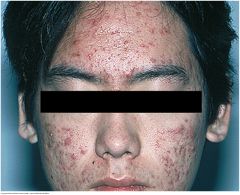
|
Acne Vulagris Primary Lesion Severe Cystic Acne |
|
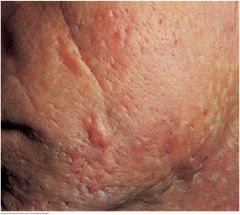
|
Acne Vulagris Secondary Lesion Acne with pitting and scars |
|
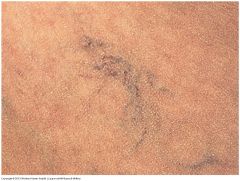
|
Vascular Lesion Spider Vein Bluish, variable size Spider shape or linear, irregular, cascading Most often on legs and near veins Often accompanies increased pressure in the superficial veins, as in varicose veins |
|
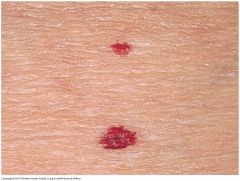
|
Vascular Lesion Cherry Angioma Bright or ruby red; may become purplish with age Round, flat; maybe surrounded by pale halo Partial blanching (temporary whitening of skin), especially with pressure applied at edge Trunk and extremities Increases in size and numbers with age |
|
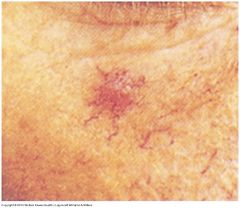
|
Vascular Lesion Spider Agioma Fiery red Central body, sometimes raised, surrounded by erythema and radiating legs Pressure on the body causes blaching of the spider Face, neck, arms, upper trunk; almost never below the waist Liver disease, pregnancy, vitamin B deficiency; also normal in some people |
|
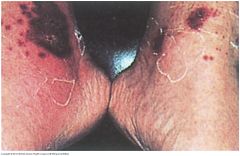
|
Purpuric Lesion Petechia/Purpura Deep red or reddish purple, fading away over time Rounded, sometimes irregular; flat No effect from pressure Variable distribution Blood outside the vessels; may suggest a bleeding disorder, or, if petechia, emboli to skin; palpable pupura in vasculitis |
|
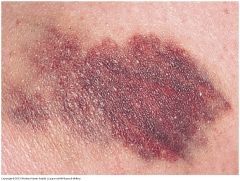
|
Purpuric Lesion Ecchymosis Puprle or purplish blue, fading to green, yellow, brown with time; variable size Rounded, oval, or irregular; may have a subcutaneous flat nodule No effect from pressure Variable distribution Blood outside the vessels; often secondary to bruising or trauma, also seen in bleeding disorders
|
|
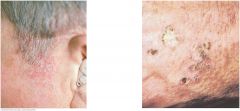
|
Skin Tumor Actinic Keratosis Typical on face and hands Round or irregular; pink, tan or grayish Sun exposed skin of older, fair-skinned people Precancerous
|
|
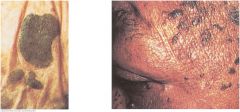
|
Skin Tumor Seborrheic Keratosis Trunk of older people, may also be on face and elsewhere Raised papules of plaques; whitish-yellow to brown; feel slightly greasy and velvety Have a "stuck on" appearance |
|

|
Skin Tumor Basal Cell Carcinoma Malignant, but almost never metastasizes Common in fair-skinned over 40 Appears on face Initiely red macule or papule; may have depressed center and firm elevated border |
|
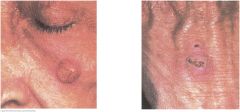
|
Skin Tumor Squamous Cell Carcinoma Face and dorsum of hand On sun-exposed fair-skinned older than 60 Can start in an acitinic keratosis Firmer and redder than Basal Cell Carcinoma |
|
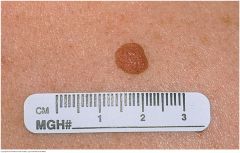
|
Typical Benign Nevi Round or oval shaped Sharply defined borders Uniform color, especially skin-coloraed, tan or brown Diamete <6 mm but >10 mm if congenital Flat or raised surface |
|
|
Malignant Melanoma |
ABCDEs Nevi that changes or atypical May have new swelling or redness beyond the border, scaling, oozing, or bleeding, or sensations such as itching, burning, or pain On darker skin, look for under the nails, on hands, or on soles of feet |
|
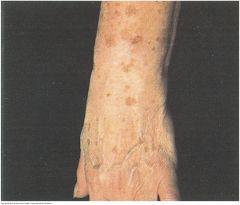
|
Solar lentigines Macules on the dorsum of hand, wrist, and forearm |
|
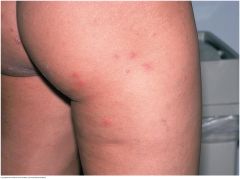
|
Pseudomonas Papules and pustules (in hot tub folliculitis) |
|
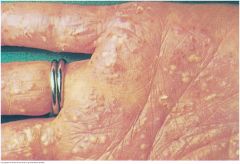
|
Pustular psoriasis Pustules on the palm |
|
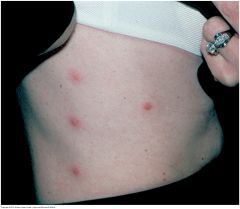
|
Chickenpox |
|
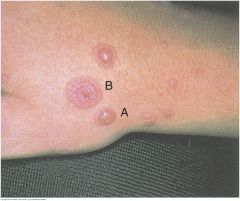
|
Erythema multiforme |
|
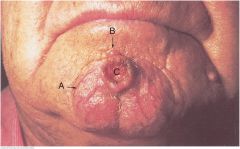
|
Squamous cell carcinoma |
|

|
Infected atopic dermatitis |
|
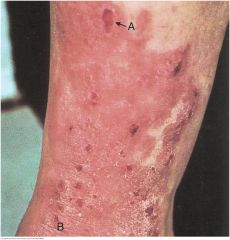
|
Lichenification and Excoriation on the leg Atopic dermatitis |
|
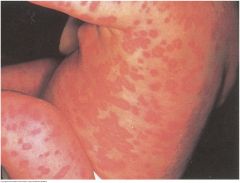
|
Urticaria Drug eruption in an infant |
|
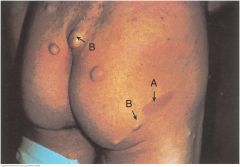
|
Combination typical of neurofibromatosis Cafe-au-lait spots and Nodules |
|
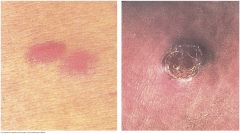
|
Kaposi's sarcoma in AIDS Malignant tumor; often multiple and may involve internal structures Left: ovoid, pinkish red plaques that lengthen along skin Right: purplish red nodule on the foot |
|
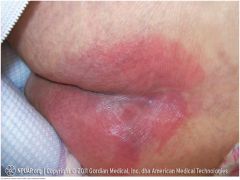
|
Stage 1 Pressure Ulcer Reddened area that fails to blanch with pressure Changes in temperature, firmness or boggy, pain or itching, or red, blue, purple; red on lighter skin |
|
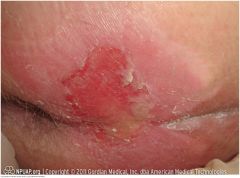
|
Stage 2 Pressure Ulcer Forms a blister or sore Partial thickness skin loss or ulceration involving the epidermis or dermis or both |
|
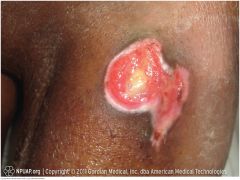
|
Stage 3 Pressure Ulcer Deepens, full thickness skin loss and damage to or necrosis of subcutaneous tissue that may extend to, but not through, underlying muscle |
|
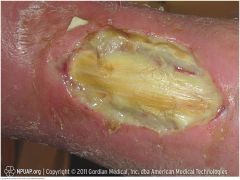
|
Stage 4 Pressure Ulcer Full thickness skin loss, with destruction, tissue necrosis, or damage to underlying msucle, bone, and sometimes tendons and joints |
|

|
Paronychia Superficial infection of the proximal and lateral nail folds adjacent to the nail plate Red, swollen and tender Infection from Staphylococcus aureus or Streptococcus |
|
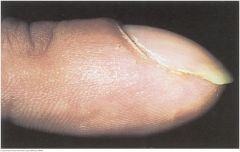
|
Clubbing of the Fingers Vasodilation with increased blood flow to the distal portion of the digits and changes in connective tissue, possibly from hypoxia, changes in innervation, genetics, or platelet-derived growth factor from fragments of platelet clumps. Seen in congenital heart disease, interstitial lung disease and lung cancer, inflammatory bowel disease, and malignancies |
|
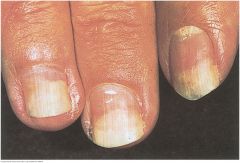
|
Onycholysis Painless separation of the whitened opaque nail plate from the pinker translucent nail bed Local cause: trauma from excess manicuring, psoriasis, fungal infection, allergic reaction to nail cosmetics Systemic cause: diabetes, anemia, photosensitive drug reactions, hyperthyroidism, peripheral ischemia, bronchiectasis, syphilis |
|
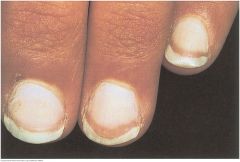
|
Terry's Nails Nail plate turns white, a distal band of reddish brown Liver disease, usually cirrhosis, heart failure, diabetes, decreased vascularity and increased connective tissue in nail bed |
|
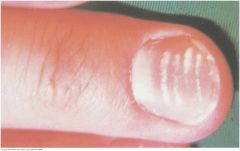
|
White Spots (Leukonychia) Trauma to nail beds Pattern is typical in overly vigorous and repeated manicuring |
|
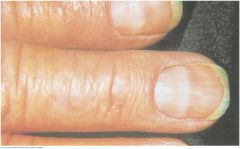
|
Transverse White Bands (Mees' Lines) Curving transverse lines Arsenic poisoning, heart failure, Hodgkin's disease, chemotherapy, carbon monoxide poisoning, and leprosy |
|

|
Transverse Linear Depressions (Beau's Lines) Temporary disruption of proximal nail growth from systemic illness Timing of illness may be estimated by measuring the distance of the line from the nail bed Severe illness, trauma, cold exposure if Raynaud's disease is present |
|
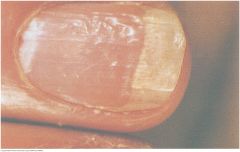
|
Pitting Punctuate depressions Caused by defective layering of the superficial nail plate Psoriasis, Reiter's syndrome, sarcoidosis, alopecia areata, localized atopic or chemical dermatitis |
|
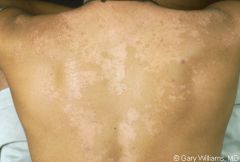
|
Tinea Versicolor Fungal infection of the skin Hypo or hyperpigmentation, scaly macules on the trunk, neck and upper arms |
|
|
Pityriasis Rosea |
Reddish oval ringworn-like papules or plagues |
|
|
Trichotillomania |
hair loss from pulling, plucking, or twisting hair. Hair shafts are broken and of varying lengths. More common in children, often in settings of family or psychosocial stress |
|
|
Tinea Capitis ("Ringworm") |
Round scaling patches of alopecia. Hairs are broken off close to the surface of the scalp. Usually caused by fungal infection from Trichophyton tonsurans from humans, less commonly from microsporum canis from dogs or cats |

